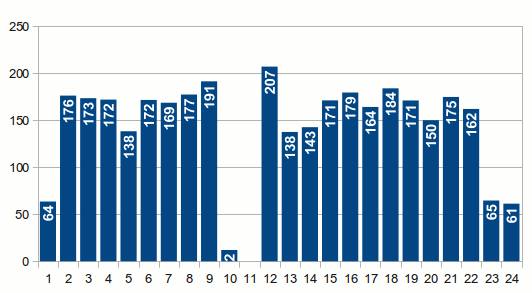Dit zijn de afstanden die er per dag gefietst zijn. Dag 4 was de rustdag.Dag 5 en 6 waren de dagen dat we rond hebben gereden in de Veluwe zonder bagage.

BramTeunissen.com
Spain - Retrospective

Overview of the route we cycled.
Purple/blue is the way out, and pink/orange is the way back.

Daily distances cycled this vacation.
On the cycling days, we averaged around 169 km/day.
Conclusion
In total, we have cycled 3412 km in 24 days, a bit more than last year. It was a lot more fun this time, mainly because the weather was good. It also was an adventurous vacation. Especially with the 50 km long stretches of nothingness, all the wild camping, and climbing the Pico Veleta. It was nice we had enough time to visit Morocco.
Spain
I really enjoyed cycling in Spain. Maybe even better than France, although that is tough to beat. In Spain are many friendly people, quiet roads, and good weather. Compared to France, the landscape is a bit less variable and the food less good. Spanish is not a complex language, so it's easy to learn enough to make yourself understood.
Pico Veleta
Climbing the Pico Veleta was one of the most fun things we did this vacation. Climbing it from the north is easier, but the climb from the south is definitely more memorable. Probably this is only possible at the height of summer, otherwise there might be too much snow.
Bicycle bus
The bicycle bus is the least bad way to get somewhere by bike. The only better way is to cycle there yourself, but that takes time. If the drivers were less blunt, it would even be an excellent way to travel. Compared to flying, the bus is more expensive but less bad for the environment. The chance of your bike arriving in one piece is probably also higher. It takes about 19 hours to get to the south of France, it is faster, easier, and cheaper than taking the train.
Costs of this cycling vacation
This cycling vacation was a bit more expensive than our average. That was because of the bus and the relatively costly food and drinks at gas stations. The campsites in Spain were also expensive, but we camped in the wild most of the time.
In total, we spent 700 euros each for our 24-day vacation. Every day we ate and drank for about 13 euros per person. That includes breakfast, a second breakfast, lunch, a gas station break, dinner, and snacks before going to sleep. That is, on the occasions we had food.
The campsites cost around 28 euros per night for both of us. The campsite in the Mediterranean was 30 euros, while the ones farther on land were 25. The one in Andorra was 13. As we only stayed on campsites eight times, this comes down to 5 euros per person per day.
Below is an overview of the total costs.
(eten en drinken = food and drinks, busreis = bus ride)

GPS
I liked navigating by GPS more than by map. By keeping it turned off as much as possible, it would last about three days on two AA batteries. I carried three sets, so we only needed to recharge them once every nine days. Following the route was quite easy on this vacation. It is also nice that the GPS confirms that you have taken the right turn, which prevents unnecessary detours. The biggest disadvantage of the GPS was the time it took to plan a good route. I used the website mapmyride.com and used a map from openstreetmap.org. While there were some errors in the map, it was generally up to date. As OpenStreetMap is made by volunteers (similar to Wikipedia), it is free, but some remote areas aren't charted yet. For example, some minor roads and villages north of the Pico Veleta were missing. Using a combination of paper maps and a GPS seems the best solution.
The bikes
Our bikes held up well this cycling vacation. We didn't have a single flat tire. Next time we will bring a better pump so we can keep our tires properly inflated. If we would cycle more over unpaved roads, a different type of bike with more suspension might be better.